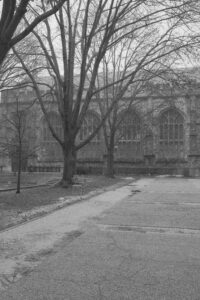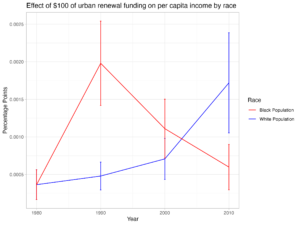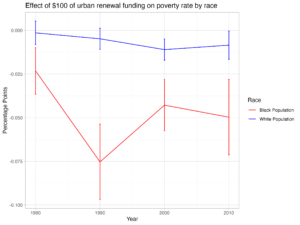Divided by Design? Urban Renewal’s Long-term Impact on Poverty and Income by Race

Picture of the University of Chicago’s Campus included because of the university’s heavy involvement in the urban redevelopment of the Hyde-Park Kenwood Historic District.

Figure 1: Visualizing the impact of per capita urban renewal funding on per capita income by race (1980 – 2010)

Figure 2: Visualizing the impact of per capita urban renewal funding on the % of people below the poverty line by race (1980 – 2010)
Article by Derik Suria
Urban renewal–state and federally-sponsored redevelopment of neighborhoods–may have made cities better off economically, but at what cost? Urban renewal was controversial because it allowed governments to forcibly seize properties and displace residents via eminent domain. Using data from the decennial census, and employing methods designed to infer causality rather than mere correlation, I quantify the differential impacts of urban renewal by race. Urban renewal had lasting positive effects on per capita income and poverty rates among Black populations. Overall property values and family incomes increased, and poverty rates declined while maintaining the racial composition of the neighborhood.
Collins and Shester examined the impact of urban renewal funding on city economic outcomes. Unsurprisingly, they found that cities with more funding experienced less poverty and unemployment alongside higher median family incomes and property values. But while city-level outcomes are important, they don’t inform us about within-city dynamics. In 2021, Lavoice showed that urban renewal resulted in a decreased share of black residents in redeveloped neighborhoods. Her findings raise the possibility that households at the lowest end of the income distribution may have been harmed even as the overall effect was positive. Perhaps, the disproportionate targeting of minority communities for redevelopment meant that urban renewal projects improved outcomes by displacing low-income communities.
I test this idea using Collins and Shester’s methodology to analyze economic outcomes from three decades (1990, 2000, 2010) disaggregated by race (Black or White). By doing so, I explore how (i) the positive effects of urban renewal faded out over time and (ii) urban renewal affected different populations. First, I looked at the number of years between 1949 and 1974 that a city could apply for urban renewal funding. This eligibility criteria is exogenous because it solely impacts economic outcomes through its predictive effect on urban renewal funding. Empirical evidence from Collins and Shester’s reduced form regression shows a correlation between enabling legislation and economic outcomes in urban areas while remaining uncorrelated with outcomes in rural areas. This controlled comparison suggests that urban renewal policies influenced economic outcomes independent of broader economic trends. Using “years under enabling legislation” helped me predict each city’s funding. Then, I used this predicted funding amount to see how it related to our economic outcomes. This indirect method, termed an instrumental variables approach, enables me to separate the effects of urban renewal funding from other factors that might simultaneously affect economic outcomes thus more accurately measuring the impact of urban renewal funding per capita on city economic outcomes.
I found that urban renewal funding had positive effects on per capita income and poverty rates. Median urban renewal funds per capita were $118.06–so I report marginal effects for a $100/capita increase in funding. A $100 increase in urban renewal funding per capita between 1949 and 1975 was associated with a predicted increase of 0.0479 and 0.198 percentage points in 1990 per capita income for White and Black populations respectively. Over the longer horizon to 2000, this effect declined slightly to 0.0707 and 0.111 percentage points. In 2010, White incomes continued to grow (0.172 percentage points), while the effect on the Black populations diminished to 0.0598 percentage points. These trends suggest short-term income benefits for Black populations that waned over time, contrasting with persistent income growth for White populations following urban renewal. By contrast, the effects on Black poverty reduction were longer lasting. A $100 increase in urban renewal funding per capita was associated with a change of -0.074% percentage points in 1990 poverty rates in black populations. Later, this effect changed to -0.042 percentage points in 2000 and -0.051 percentage points in 2010. All results were significant at a 95% level. This suggests that positive changes to per capita income faded out by 2010 but Black populations experienced sustained reductions in poverty rate. At the same time, I find no evidence that urban renewal funding was associated with changes in racial demographics across cities.
While the results suggest urban renewal was successful in reducing black poverty without shrinking the black community, it is difficult to tell whether individuals displaced by urban renewal stayed in the city. It is possible that gentrification occurred within the black community. Nonetheless, my findings suggest urban renewal had persistent modest positive effects.
Article by Derik Suria ‘24
Student Manager, Economic Journalism
Lowe Institute for Political Economy


